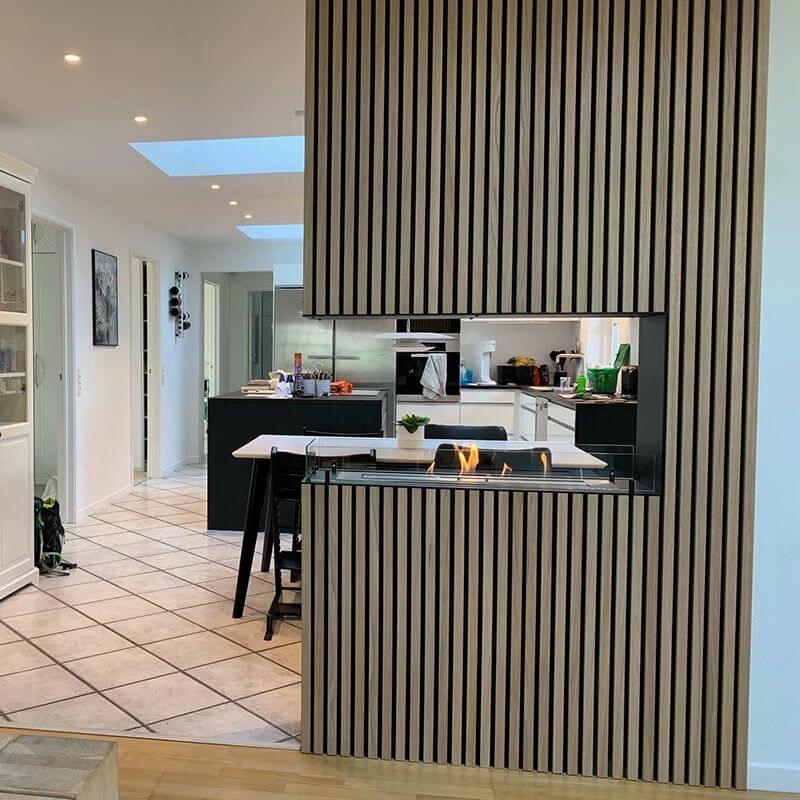When it comes to enhancing the aesthetics and functionality of a space, slat walls have emerged as an innovative solution. Homeowners, DIY enthusiasts, and interior design professionals are increasingly choosing slat walls for their versatility, modern look, and practical benefits. Here’s why slat walls are a smart design choice and how they can transform your living or work space.
What Are Slat Walls?
Slat walls are wall panels featuring evenly spaced vertical or horizontal grooves. Made from high-quality materials like wood or MDF (medium-density fiberboard), slat walls are not just visually appealing but highly practical. They can be installed in living rooms, offices, retail spaces, and garages to provide both a decorative element and a functional backdrop.
Key Features of Slat Walls:
- Customizable: Available in various finishes, colors, and materials to match any interior theme.
- Easy Installation: Many slat wall systems are designed for easy mounting, perfect for DIY enthusiasts.
- Durable: High-quality slat walls can withstand weight and last for years without significant wear.
Benefits of Choosing Slat Walls for Your Space
1. Enhanced Aesthetic Appeal
One of the most significant reasons slat walls are a smart design choice is their unique ability to elevate the overall look of a room. The sleek lines of slat walls create a modern, structured appearance that can make any space feel polished and cohesive.
Why This Matters:
- Modern and Minimalistic Look: Slat walls contribute to a clean and organized atmosphere, aligning well with contemporary design trends.
- Variety of Styles: Whether you prefer a rustic wood finish or a sleek, painted surface, slat walls offer customizable options that fit any design preference.
2. Functionality Beyond Decoration
While slat walls are undeniably stylish, they are also functional. The grooves in slat walls can be used for more than just visual interest; they serve as anchors for various accessories and shelving solutions.
Practical Uses Include:
- Storage Solutions: Attach hooks, baskets, and shelves for organizing tools, books, or décor items.
- Display Space: Ideal for retail settings to showcase products in an attractive, organized manner.
Visual Element Suggestion: Consider a simple diagram illustrating different accessories attached to slat walls, highlighting their versatile uses.
How to Integrate Slat Walls Into Your Space
1. Choose the Right Material and Finish
Selecting the appropriate material for your slat walls is essential for achieving the desired look and durability. Options range from natural wood panels that offer a warm, inviting feel to painted MDF for a more uniform appearance.
Material Choices:
- Wood Slat Walls: Ideal for adding texture and warmth. They come in various types like oak, pine, or reclaimed wood for a more eco-friendly option.
- MDF Panels: Cost-effective and easy to customize with paint or finishes.
2. Installation Tips
Installing slat walls is straightforward, especially if you opt for panels that come pre-finished and ready to mount. Here’s a simple step-by-step guide:
- Measure Your Wall: Ensure accurate measurements to avoid panel gaps.
- Prepare the Surface: The wall should be clean and dry before installation.
- Apply Adhesive (Optional): To enhance stability, use a strong adhesive alongside screws.
- Mount the Panels: Align and secure the panels with screws or nails, ensuring even spacing.
Pro Tip: Use a level to keep the panels aligned for a professional finish.
Why Slat Walls Are a Smart Design Choice for Various Settings
Residential Spaces
Slat walls are not only practical for garages or offices; they have become a popular feature in homes. Here’s why:
- Living Rooms: Use slat walls as accent features behind sofas or entertainment centers for a sophisticated look.
- Bedrooms: Install slat walls as headboards to add depth and interest.
- Kitchens: Hang utensils, pots, and decorative items using slat wall grooves for easy access and organization.
Commercial and Retail Spaces
Slat walls are highly regarded in the retail industry due to their adaptability. They allow shop owners to rearrange displays effortlessly, ensuring that merchandise always looks fresh and inviting.
Benefits in Retail Settings:
- Customizable Displays: Change and reposition items as needed.
- Professional Appearance: Keeps products organized and visually appealing.
Tips for Maintaining Slat Walls
To ensure your slat walls maintain their beauty and function over time, follow these maintenance tips:
- Regular Cleaning: Dust your slat walls weekly with a soft cloth or vacuum with a brush attachment.
- Avoid Harsh Chemicals: Use mild soap and water to clean any spills or stains.
- Inspect Accessories: Check that hooks and shelves are secure and not overburdened.
Conclusion: Why Slat Walls Are a Smart Design Choice
Slat walls offer a blend of beauty, versatility, and practicality that few other wall design options can match. Whether you’re updating a room in your home or looking for an efficient way to display products in a retail space, slat walls are an excellent solution. With various styles, materials, and customization options, slat walls provide a personalized touch that makes any area stand out.
FAQs
-
What are slat walls typically made of?
Slat walls are commonly made from wood, MDF, or composite materials. The choice depends on the desired aesthetic, durability, and budget.
-
Are slat walls easy to install?
Yes, slat walls are designed for relatively simple installation, especially when using pre-finished panels. Basic DIY skills and tools are typically sufficient.
-
Can slat walls hold heavy items?
High-quality slat walls can support shelves, hooks, and other accessories for moderate to heavy items, depending on their construction and mounting method.
-
How do I maintain slat walls?
Regular dusting and the use of mild soap for cleaning can keep slat walls in top condition. Avoid harsh chemicals that could damage the finish.
-
Are slat walls customizable?
Yes, slat walls come in various finishes and colors, making them easy to customize to match different room designs.








